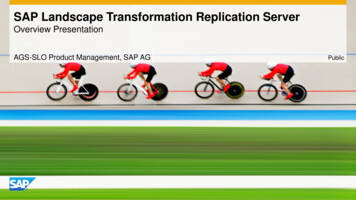Business Process Management Suite (Bpms) Market Changes 2009 2015
INFORMATIONSYSTEMS INMANAGEMENTInformation Systems in Management (2016) Vol. 5 (4) 585 592BUSINESS PROCESS MANAGEMENT SUITE (BPMS) MARKETCHANGES 2009 2015ADAM WASILEWSKIDepartment of Computer Science and Management,Wroclaw University of Technology, Wroclaw, PolandIT tools supporting the BPM approach developed rapidly in the last 10 years.Initially were available simple solutions for modeling and optimization of businessprocesses. The next generation has offered business process implementation andmonitoring in the real environment of the organization. Finally user requirementsforced vendors to add a bit of “intelligence” to their applications and iBPMSentered on the market. The iBMPS market is still immature but some trends can beseen. The source for such analysis can be found in analytical reports provided byrenowned research and advisory companies. In this paper was presented analysis ofBPMS and iBMPS markets based on Gartner’s Magic Quadrant reports from years:2009, 2010, 2012, 2014 and 2015.Keywords: business process, management, IT tools, BPM1. IntroductionBusiness Process Management (BPM) is an approach that let to improvecorporate performance. Usually it needs accurate IT support that let to model,design, implement and analyze business processes in the organization.Evolution of IT tools supporting BPM shows three classes of applications: Business Process Modelling (BPM) products Business Process Management Suite (BPMS) products Intelligent Business Process Management Suite (iBPMS) products.
2. IT tools for Business Process ManagementBusiness Process Modelling (BPM) tools allow to model business processesusing well-known standards and notations (e.g. EPC, BPMN, UML) and optimizethem on the base of pre-execution simulations and post-execution analysis ofmetrics.Business process management suite (BPMS) can be defined as “applicationinfrastructure to support BPM projects and programs”. Such application supportsthe entire process improvement life cycle: process discovery and its modelling design, implementation, monitoring analysis and continuous improvement.Basic functionality of BPMS [1] includes: support the modelling and analysis of business processes (includingtasks/activities, roles, decisions/logical operators, flows, collaboration, events,goals, etc.) support process change, in modelling, implementing and execution stage withhistory of changes coordinate every type of interaction patterns (human2human, human2system,system2system) among user tasks, system tasks, internal and external dataresources enable participants do use (read and write) information within instances ofbusiness processes assigned to them support the definition and management of business rules and business logic support collaboration during process design and redesign support notification of activities and events for participants support the monitoring and reporting of transactions and business processinstances support process simulation and optimization on the base of statistical/estimated,historical and real-time data ability to integrate with external assets/applications using Web Services (SOAP,REST) ability to interoperate in Service Oriented Architecture (SOA) paradigm ability to store process artifacts (e.g. models, process and rules definitions,services etc.) to reuse them in different processes support designing of user interfaces (UI) for user tasks.586
BPMS expands functionality of pure-play Business Process Modelling tools byprocess implementation and monitoring. But sometimes BPMS solutions wereunable to address new challenges – increasing data volumes, rapid change odbusiness environment, complex real-time decision-making capabilities and theyevolved to iBPMS (intelligent Business Management Suite).Intelligent Business Process Management Suite (iBPMS) - according toGartner Group - “expands the traditional BPMS by adding the new functionalityneeded to support Intelligent Business Operations (IBO), such as real-time businessanalytics, deep complex-event processing (CEP), social media to support socialbehavior and collaboration, and expanded technologies to support growingrequirements for mobility”.Extended functionality of iBPMS includes [3]: real-time business analytics to improves decision-making process complex-event processing (CEP) to analyze high volumes of data expanded analytical capabilities in business activity monitoring (BAM) mobile tools interface to provide access to platform from every place social media interface to use context and social data in business process logic integration with on-demand analytical predictive (statistical) and simulationtools access to new information sources including video, audio and social streams.Evolution of IT tools for Business Process Management Tools and market trendsare clearly visible in reports provided by consulting companies as Gartner Groupand Forrester Research.3. Gartner’s Magic QuadrantGartner Inc. was founded in 1979, and now is the world's leading informationtechnology research and advisory company. One of well-known analyticalmethodology provided by Gartner is Gartner Magic Quadrant.A Magic Quadrant gives graphical positioning of technology providers divided intofour types: Leaders providers that “execute well against their current vision and are wellpositioned for tomorrow” Visionaries providers that “understand where the market is going or have avision for changing market rules, but do not yet execute well” Niche Players providers that “focus successfully on a small segment, or areunfocused and do not out-innovate or outperform others” Challengers providers that “execute well today or may dominate a largesegment, but do not demonstrate an understanding of market direction”.587
4. Market trends between 2009 and 20154.1. BPMS changes to iBPMS (2010-2012)Ability to executeIn 2010 Gartner presented its final report for BPMS tools (fig. 1). In thisreport 9 vendors were classified as “leaders”, 10 vendors as “visionaries”. In total –27 vendors were included in the report.Figure 1. Gartner’s Magic Quadrant for BPMS at 2010 [2]But 2 years later, when Gartner presented the first report for iBPMS (fig. 2)only 13 vendors (including fact that Lombardi was acquired by IBM in 2010 andits software was integrated with IBM WDPE as IBM BPM package) met inclusioncriteria. It means that only about 50% of vendors changed functionality of theirsystems to offer “intelligent” BPMS.588
Ability to executeFigure 2. Gartner’s Magic Quadrant for iBPMS at 2012 [3]In 2012 only 3 vendors were classified as “leaders”: Pegasystem (PegaRULES Process Commander PRPC v 6.3) Appian (Appian BPMS v.6.6.1) IBM (IBM BPM 7.5.1)Two former BPMS leaders (Oracle, Software AG) were classified as “visionaries”and one former “visionary” (Cordys) moved to “niche players” class. Suchsituation shows that transformation from BPMS to iBPMS is not easy and obviouseven for big, well-known vendors.589
4.2. Growth of iBPMS (2012 2015)Ability to executeBetween 2012 and 2015 Gartner has presented 3 reports for iBPMS. On this basecan be shown changes in vendor’s positioning (fig. 3).Figure 3. Positioning of iBPMS vendors 2012 – 2015. Source: own preparation on thebasis of Gartner Group materialsIn those reports were no changes in the list of leaders but their positionschanged notably. Pegasoft and Appian significantly increased factor “ability toexecute” and IBM BPM had this factor on the constant, low (for leader) level. Onthe other hand, in this class was no clear direction of change of the second factor(“completeness of vision”) – e.g. for IBM this factor grew in the first period (20122014) and declined in the second period (2014-2015) but for Pegasystems declinedin the first period and them came back to the start level in the second period.In the “visionaries” class the set of vendors has not changed as well. Three mostfamous vendors nearly maintained their positions - Oracle moved on the borderbetween “leaders”, “visionaries” and “niche players”, Software AG improved itsapplication year by year in both directions, Tibco kept its “completeness of vision”but changed (up and then down) “ability to execute”.590
4.3. Overall market change (2009 2015)Ability to executeAnalysis of reports from 2009 and 2015 lets to compare positioning of vendorswho were present in both reports (fig. 4).Figure 4. Comparison of BPMS and iBPMS markets in 2009 and 2015.Source: own preparation on the basis of Gartner Group materialsPegasystems is still classified as “leader” but its position on iBPMS market isslightly lower than on BPMS market.Appian significantly improved its position in both dimensions and to become a realleader on the iBPMS market.IBM improved its position in terms of “completeness of vision” but “ability toexecute” is similar in 2009 and 2015.Oracle was in the “challenger” on BPMS market but on iBPMS is classified as“visionaries”.Tibco and Software AG lost their positions and on iBPMS market are only in“visionaries” class.591
5. ConclusionModern IT tools supporting Business Process Management approach can offer awide range of functions. The key elements of today’s iBPMS applications are [5]: Process Orchestration Engine Graphical Model-Driven Composition Environment Content Interaction Environment Human Interactions On-Demand Analytics Process Intelligence and Business Activity Monitoring Business Rule Processing Connectivity Management and Administration Registry/Repository.According to the newest Gartner’s report three vendors offer product with highability to execute and high completeness of vision. Analysis of previous reportsshows that those vendors (Pegasystems, Appian and IBM) are only leaders for last4 years. Analysis of the trends indicates that there is no reason to think that anyother vendor will advance to the “leader” class soon.REFERENCES[1] Hill J.B., Cantara M., Kerremans M., Plummer D.C. (2009) Magic Quadrant forBusiness Process Management Suites, Gartner RAS Core Research Note G00164485[2] Sinur J., Hill J.B. (2010) Magic Quadrant for Business Process Management Suites,Gartner RAS Core Research Note G00205212[3] Sinur J., Schulte W.R., Hill J.B., Jones T. (2012) Magic Quadrant for IntelligentBusiness Process Management Suites, Gartner RAS Core Research Note G00224913[4] Jones T., Schulte W.R., Cantara M. (2014) Magic Quadrant for Intelligent BusinessProcess Management Suites, Gartner RAS Core Research Note G00255421[5] Dunie R., Schulte W.R., Cantara M., Kerremans M. (2015) Magic Quadrant forIntelligent Business Process Management Suites, Gartner RAS Core Research NoteG00258612592
Business Process Management Suites , Gartner RAS Core Research Note G00164485 [2] Sinur J., Hill J.B. (2010) Magic Quadrant for Business Process Management Suites , . Kerremans M. (2015) Magic Quadrant for Intelligent Business Process Management Suites , Gartner RAS Core Research Note G00258612. Title: Vol_5(4)_o1 Author: Dell Created Date: 8 .
informed business rules, specified in the design phase, to be enacted. This entails that appropriate connections are put in place between a BPMS and accounting information systems, as well as realising cost-based rules, triggers, resource allocation strategies, etc. RQ3. How can cost information enhance operational support in a BPMS/PAIS?
Business process analysis (BPA) tools are intended primarily for use by: Business architects, who require robust solutions aligned with enterprise architecture Business process (BP) architects, who redesign BPs at a conceptual level, regardless of whether there would be a business process management suite (BPMS) implementation
ScanTools Pro 4 dS Performance Suite Plus 6 dS Performance Suite Pro 19 dS Performance Suite Premium 25 dS Neuro Suite Plus 31 dS Neuro Suite Pro 37 dS Neuro Suite Premium 43 dS MSK suite 47 dS Body Suite 51 dS Liver Suite 55 dS Breast Suite 59 dS Cardiac Suite Pro 63
Vacuum System Design in a Compact Lattice Space: Increase from 2 to between 5 and 7 bending magnets, multiple radiation fans. Less space for BPMs, bellows, isolation valves. Stronger magnetic fields, smaller magnet bores, typically 26mm, low conductance vacuum chamber. Stringent alignment stability for BPMs, absorbers, chambers.
Regression Testing Process and Issues Test-suite maintenance Obsolete test cases Test suite Tval Regression test selection Test suite T' Test-suite prioritization Prioritized Test suite T' T est-suite augmentation Test suite Taug T est-suite minimization Redundant test cases Minimized test suite est-case manipulation
Several BPMS vendors provide complete software suites such as Oracle BPM Suite [33], Appian BPM Suite [34], Bizagi [35], jBPM [36], and Activi [37] that can support the BPM lifecycle: process modelling, process analysis, process implementation, and process monitoring and evaluation.
SAP HANA Appliance SAP HANA DB In-Memory A io BI Client non-ABAP (SAP supported DBs) SAP Business Suite SAP Business Suite SAP Business Suite SAP Business Suite SAP Business Suite SAP Business Suite SAP Business Warehouse SAP HANA DB r In-Memory Source Systems SAP LT Replication Ser
the risks of adventure travel. Adventure travel is supposed to be challenging. But regardless of your age, destination or chosen activity, your safety should be of paramount importance. BS 8848 sets standards to minimize the risks of adventure travel. Knowledge of the standard is important to anyone organizing, or taking part in, an overseas venture. 2 Hundreds of thousands of people take part .























